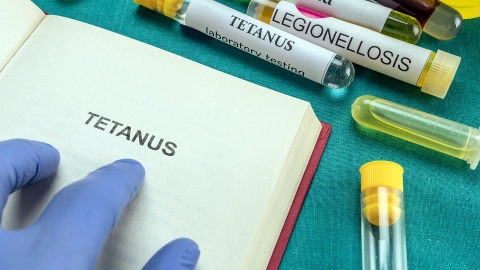Conditions Diphtheria
ICD codes: A36 Z22.2 What are ICD codes?
Diphtheria is a bacterial infectious disease, primarily affecting the skin or upper respiratory tract. The diphtheria pathogens (i.e., the microbes causing the infection) produce a toxin that enters the blood and can damage internal organs. In rare cases, the disease is fatal. Vaccination offers protection.
At a glance
- Diphtheria is a severe, life-threatening bacterial infection caused by corynebacteria.
- The bacteria mainly attack the skin (cutaneous diphtheria) or, less frequently, the mucous membranes in the airways (respiratory bacteria).
- The bacteria also produce a toxin that spreads throughout the body and can damage important organs.
- Diphtheria is treated with an antitoxin and antibiotics.
- Vaccination offers effective protection against diphtheria.
Note: The information in this article cannot and should not replace a medical consultation and must not be used for self-diagnosis or treatment.

What is diphtheria?
Diphtheria is a bacterial infectious disease that is found worldwide. It only occurs rarely in Germany today thanks to protective vaccinations.
The bacteria attack the skin or the mucous membranes in the airways. They also produce a toxin that spreads throughout the body and can damage important organs.
Vaccination offers protection against diphtheria.
Types of diphtheria
There are two main types of diphtheria:
- Respiratory diphtheria (sometimes also called diphtheria of the throat or diphtheria of the upper respiratory tract): The bacteria become established in the airways and cause symptoms there. This type can be fatal – it is estimated that between 5% and 10% of people infected with respiratory diphtheria will die as a result.
- Cutaneous diphtheria (also known as diphtheria of the skin): This type can occur after small surface injuries or insect bites. It often occurs in environments with poor hygiene. Pets and farm animals can be the source of infection.
What are the symptoms of diphtheria?
The symptoms and severity of diphtheria depend on the type of diphtheria a person has.
Symptoms of respiratory diphtheria
Respiratory diphtheria has symptoms including:
- weakness
- sore throat
- fever
- difficulty swallowing
- barking cough (croup cough)
- wheezing and shortness of breath
- hoarseness to complete loss of the voice
- swollen lymph nodes in the throat
- sweet-smelling, offensive breath odor
- bluish-red discoloration of the skin (cyanosis)
- restlessness and anxiety
- paleness
The toxin destroys healthy tissue in the respiratory tract. Within 2 to 3 days, the dead tissue forms a thick, gray-brown coating, which can then accumulate in the throat or nose.
Doctors call this coating a pseudomembrane. It can cover tissue in the nose, on the tonsils and larynx and in the throat, making it very difficult to breathe and swallow. This can be fatal in young children.
Symptoms of cutaneous diphtheria
Cutaneous diphtheria causes the following symptoms:
- swelling
- redness
- wounds that have a punched-out appearance
- a slimy coating occurring on the wounds
Video Are childhood diseases dangerous?
The video below outlines the most common childhood diseases and the symptoms they present.
This and other videos can also be found on YouTube
Watch nowThe privacy policy indicated there applies.
How do people get diphtheria?
Respiratory diphtheria is caused by the bacterium corynebacterium diphtheriae. This type of bacteria is found only in humans.
Cutaneous diphtheria is caused by the bacteria corynebacterium ulcerans and corynebacterium pseudotuberculosis. In nature, both types of bacteria are only found in animals. Cutaneous diphtheria is therefore a zoonotic disease – a disease that can pass from animals to humans.
How are diphtheria pathogens transmitted?
Respiratory diphtheria is spread from person to person by means of droplet infection. In other words, if an infected person sneezes or coughs, they release droplets that contain the virus. These can be dispersed through the air and inhaled by other people. Occasionally, people contract respiratory diphtheria as a result of an infection with cutaneous diphtheria.
Cutaneous diphtheria is mainly transmitted by smear infection. For example, it can be contracted by touching the open wounds of an infected individual. However, it is also possible to contract diphtheria by touching objects that are contaminated with diphtheria pathogens. This is mainly the case in living conditions where hygiene standards are poor – for example, among homeless people.
How common is diphtheria?
Infections with diphtheria pathogens occur worldwide. Diphtheria is most prevalent in subtropical countries such as India. The disease also occurs in many countries in Africa, Asia, the South Pacific and Eastern Europe.
However, the serious effects of the disease have decreased significantly thanks to infant and child vaccination programs.
Cases in Germany
Diphtheria is a notifiable disease in Germany. The number of cases of cutaneous diphtheria has been increasing since 2010.
16 cases of diphtheria were reported in this country in 2020 – 15 individuals had cutaneous diphtheria, while one person had respiratory diphtheria.
What are the possible complications of diphtheria?
The toxin produced by the diphtheria pathogens enters the bloodstream and can damage internal organs. Doctors refer to serious cases such as this as toxic diphtheria.
Possible complications include:
- blocked airways
- lung infections – ranging from pneumonia to respiratory failure
- inflammation of the cardiac muscle (myocardium)
- nerve damage (polyneuropathy)
- paralysis
- coma
How can diphtheria be prevented?
To prevent diphtheria from spreading in the community, it is important for infected individuals and anyone who suspects they could be infected to isolate.
Diphtheria can be effectively prevented by vaccination. The vaccine targets the toxin, not the bacteria. This is why the pathogen can multiply in the body and sometimes trigger symptoms such as fever or general weakness, even if a vaccine has been administered.
The diphtheria vaccine is based on the toxin produced by the pathogen that causes respiratory diphtheria. This toxin is similar to that produced by the pathogen that causes cutaneous diphtheria. However, it is not clear how effective the vaccine is against cutaneous diphtheria.
The Standing Committee on Vaccination in Germany (Ständige Impfkommission, STIKO) recommends that all babies, children, adolescents and adults be vaccinated against diphtheria as standard.
Recommended vaccinations
Infants should receive their first doses at the ages of 2 months, 4 months and 11 to 14 months. This is usually administered as part of the 6-in-1 vaccine, which also protects against tetanus, whooping cough (pertussis), polio (poliomyelitis), hepatitis B and infection with the haemophilus influenzae type b (Hib) bacterium.
The immunity provided by this primary immunization decreases over time. Therefore, a first booster vaccine is required between the age of 5 and 6 and a second is required between the ages of 9 and 17.
It is then recommended that people receive a booster vaccine every 10 years. Various individual and combination vaccines are available as boosters.
Do you have questions about the diphtheria vaccine and STIKO recommendations? Answers to the most frequently asked questions can be found on the Robert Koch Institute website.
Video How do vaccinations work?
The video below explains how a vaccination works.
This and other videos can also be found on YouTube
Watch nowThe privacy policy indicated there applies.
How is diphtheria diagnosed?
Doctors typically diagnose diphtheria on the basis of a physical examination. To confirm a suspected case of diphtheria, it is important to detect the pathogen. Doctors therefore take a swab sample from the back of the throat or a wound swab and send these to a laboratory.
A bacterial culture is grown in the lab in order to detect the pathogen. It can also be detected using molecular biology-based methods, such as PCR testing. In this process, the genetic material of the bacteria (not the bacteria itself) is detected.
How is diphtheria treated?
There is an antitoxin for the diphtheria toxin. However, the antitoxin is not effective if the toxin is already bound to the somatic cells.
For this reason, doctors will start treatment immediately if diphtheria is suspected, rather than waiting for the laboratory results.
Treatment with antitoxin
Cutaneous diphtheria of the skin is not as life-threatening as respiratory diphtheria. That is why the antitoxin is administered for diphtheria of the skin only if the wound or abscess is larger than a Euro coin and has the standard gray-brown coating.
Important: The antitoxin is usually obtained from horses. Some people have an allergic reaction to this substance, which can lead to complications. In the worst case scenario, a person may have a fatal allergic reaction (anaphylactic shock). Therefore, people suspected of having diphtheria are treated in a hospital with an intensive care unit.
Treatment with antibiotics
In addition to the antitoxin, doctors prescribe antibiotics to kill the living bacteria.
People diagnosed with diphtheria are typically no longer contagious 48 hours after the start of antibiotic treatment.
However, it is important that they continue with antibiotic treatment, typically for two weeks. This ensures that all bacteria have left the body or have been killed.
Doctors then repeat tests to determine whether the body is clear of the pathogen.
Close contacts suspected of having diphtheria are usually given antibiotics on a preventive basis. Doctors also use the term “post-exposure prophylaxis” (PEP) in this case.
- Centers for Disease Control and Prevention (CDC). Epidemiology and prevention of vaccine-preventable diseases. Diphtheria. Aufgerufen am 17.02.2023.
- Konrad R, Hörmansdorfer S, Sing A. Possible human-to-human transmission of toxigenic Corynebacterium ulcerans. Clin Microbiol Infect. 2015 Aug;21(8):768-71. doi: 10.1016/j.cmi.2015.05.021.
- Robert Koch-Institut (RKI). Epidemiologisches Bulletin. Corynebacterium ulcerans – ein Emerging Pathogen? 22. Februar 2018/Nr. 8.
- Robert Koch-Institut (RKI). Infektionsepidemiologisches Jahrbuch meldepflichtiger Krankheiten für 2020.
- Robert-Koch-Institut (RKI). RKI-Ratgeber: Diphtherie. Aufgerufen am 17.02.2023.
Reviewed by the German Society for Pediatric Infectiology (Deutsche Gesellschaft für Pädiatrische Infektiologie e.V.).
As at:





